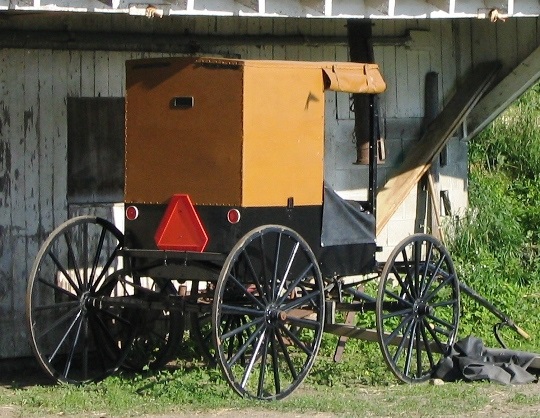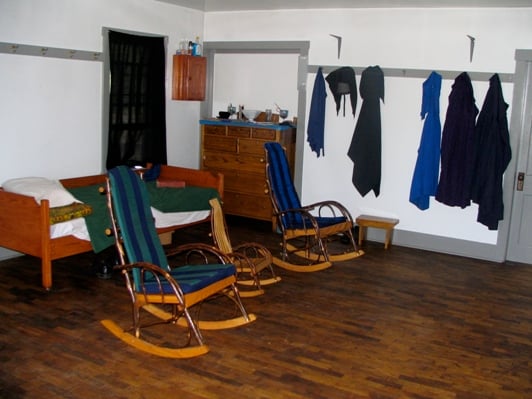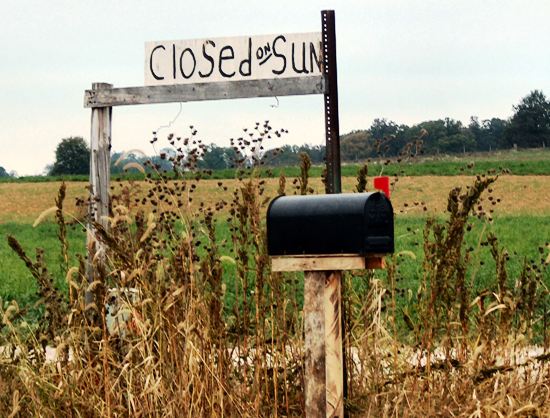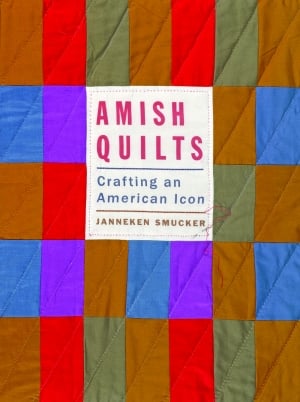New York Amish: Book giveaway and interview with Karen Johnson-Weiner
“New York” and “Amish” may seem an odd match.
But the Empire State has seen its Amish population soar in recent years, and is currently home to the 5th-largest grouping of Amish in North America.
SUNY-Potsdam Professor of Anthropology Karen Johnson-Weiner has spent years researching the various Amish communities in New York.
Karen’s new book New York Amish: Life in the Plain Communities of the Empire State is the first to explore Amish settlement in the state.

While you won’t find any Amish on the island of Manhattan, since 1949 they have established nearly three dozen settlements across the state, from Western NY to the North Country near the Canadian border.
Today, Karen answers questions about the Amish of New York state, in this first part of a 2-part interview.
New York Amish giveaway
We’re also giving away a copy of New York Amish. There are 2 ways to enter this contest:
 Leave a comment or question on this post=1 entry
Leave a comment or question on this post=1 entry- Mention this contest on your own blog (1 entry) and/or Facebook (1 entry). (drop a quick email to amishamerica@gmail.com to let me know you did)
…for a possible total of 3 entries. The winner will be drawn at random in one week’s time, on Thursday Sep 16th. (entries accepted until midnight EST Wed Sep 15th)
I found the book fascinating and one of the best I’ve read on the Amish. I hope you will too. Thanks to Karen for sharing such an interesting interview.
Karen Johnson-Weiner on New York Amish: Part 1
Amish America: In recent years the Amish population in New York has grown by leaps and bounds. What are reasons Amish have found the Empire State attractive for settlement?
Karen Johnson-Weiner: The Amish are moving for different reasons. Many are coming from large, crowded settlements, while others might be avoiding internal conflicts. Some find they can no longer afford to purchase property in their home community—or there may be no farms available. They’ve come to New York State because there is available land at reasonable prices. New York offers them the opportunity to maintain—or even return to—an agrarian lifestyle.
AA: In New York Amish you examine the wealth of diversity across Amish society in New York, ranging from Swartzentruber to New Order communities. Can you explain the implications of “being Amish” in different ways, i.e., how does this diversity affect daily life and relationships across Amish communities?
KJW: How a group is Amish—its Ordnung and the way the Ordnung structures the life of the church—shapes the work one can do, whether one can work with non-Amish and how and where, what kinds of technology one will use in the home or in the shop, how one will dress, whether your buggy has a top or a windshield, what one will study in school, and with which other church communities one will fellowship.
For example, members of the most conservative Swartzentruber factions are not permitted to work “in town,” and so carpenter crews can build houses only in rural areas—their counterparts in more progressive communities can work on homes and garages located within village or city limits.

From birth to death, one’s life is shaped by how one’s community is Amish. A Swartzentruber baby wears cloth diapers and no rubber pants, while a baby in a more progressive community may wear a disposable diaper, meaning that washing diapers takes up much more of a Swartzentruber mother’s time than these tasks do in more progressive communities. Moreover, since the cloth diapers on that Swartzentruber baby cannot be the “prefolded” kind most stores sell, the mother has more sewing to do to make diapers.
Because the Swartzentruber Amish and other conservative groups have not accepted gas refrigerators or freezers (for example), women do much more canning than those in communities that have these things. And, if your community has freezers, then the men don’t need to harvest ice in wintertime.
One’s church determines how one will do other tasks as well—some groups have chain saws and others don’t, some permit indoor plumbing while others sanction only (manual) hand pumps, and some permit battery-operated table lamps while others rely on kerosene lanterns. Women who must oil their wood floors plan housework differently than those who wash linoleum. How one is Amish also limits social interaction. Young folks from one church group won’t date someone from a group that’s not in fellowship with their own.

Amish diversity affects Amish interaction with the non-Amish world as well. The Ordnung may limit the extent to which a group can comply with local ordinances. Swartzentruber Ordnungs do not permit church members to display the slow moving vehicle sign on their buggies or wagons. Many groups have had difficulty with local zoning boards. Members of some very conservative Amish churches do not have social security numbers, which makes banking difficult.
AA: You describe the differing non-Amish responses to Amish settlement in New York, ranging from the newspaper letter-writer who described Amish buggies as “a good omen” to the one who rather viewed Amish transportation as “anything but…picturesque”, and “an accident waiting to happen.”
Why the disparate reactions? In what ways have Amish cooperated with the non-Amish public in New York, and how have they come into conflict?
KJW: Amish families often become good friends with their neighbors. Depending on the type of Amish, members of the community may be working for or with non-Amish individuals or businesses, and Amish church members from all communities get to know the non-Amish with whom they interact. Even Swartzentruber women running farm stands make close friends among their customers!

When there is difficulty—whether personal or resulting from natural disasters—the Amish are there to help their neighbors. When dairy farms were hit hard during an ice storm that cut off power across a wide swath of northern New York State, the Amish pitched in to help milk cows by hand.
Amish also pitched in to help when flooding affected New York’s Mohawk Valley. More routinely, many Amish contribute items to local fire department fundraisers, and Amish parents routinely send their children to help chore for elderly neighbors.

When the first Amish families move into a region, their non-Amish neighbors are often unsure about what to expect from them. Some praise them as pioneers, individualists, spiritual gurus, and back-to-the-land environmentalists, but others reject them as scofflaws, and religious extremists. Moreover, there are a lot of myths, half-truths, and imaginative fictions about the Amish, and when the Amish don’t behave like their new neighbors expect them to, there is sometimes resentment.
The Amish want to be good neighbors, but being good church members comes first, and this may cause difficulties—especially since one group may permit things that a neighboring group does not, causing those in the mainstream to wonder what’s really Amish.
Major conflicts have come over issues such as the refusal of very conservative churches to use the slow moving vehicle triangle on buggies and wagons, the inability of groups to meet state requirements for building permits, child labor, and children’s healthcare.
As I noted in my book, New York Amish, the Amish sincerely believe that they must remain separate from the world, and so being different or “unconformed” is a sign of faith. After all, the Amish say, if God’s truth is unchanging, then God’s church must also resist change. And because they are different in a fallen world, the Amish expect that they will be persecuted like their Anabaptist ancestors.

As a result, when Amish church members have to go to court because, having followed the Ordnung, they have violated different statutes and laws, they do so firm in their belief that they are suffering for their faith. Worldly society establishes the norms to which Amish society cannot conform and, thus, helps to shape Amish life. But, since rejection of social norms is, after all, rejection of those who establish them and the laws that perpetuate them, conflict may be inevitable.
AA: “Swiss” ethnicity Amish are generally lesser-known in the public. You detail Swiss Amish settlement in New York in a chapter devoted do this group. How do Swiss Amish differ from Pennsylvania German ethnicity Amish? To what degree do Swiss Amish interact with non-Swiss communities in New York?
KJW: The Swiss Amish have a somewhat different history than their Pennsylvania German counterparts; although they chose an Old Order path, few Swiss Amish leaders attended the 19th century Diener Versammlungen, which helped to define the Old Order Amish churches.
The Swiss Amish have a reputation for being stubborn, and their communities have been shaped by internal conflict. Today the large Swiss Amish settlements in Indiana are marked by distinct clothing, buggy styles, and, of course, the Shwitsa (Swiss German) dialect they speak, which their Pennsylvania German counterparts find difficult to understand.
The three related Swiss settlements in New York State, which trace their roots to Indiana, all have historical and family connections to Old Order non-Swiss Amish settlements in Michigan and Indiana, and so their black buggies with tops and patterns of dress help them look much like their non-Swiss Amish counterparts in those regions.
The Swiss communities in New York cooperate with their Amish neighbors, joining in barn raisings and shopping at Amish-owned businesses. But their social interaction is with those groups with whom they fellowship.
————————————————————————————–
Continue reading part 2 of the New York Amish interview with Karen Johnson-Weiner. Read more on New York Amish in the Amish State Guide, or find Empire State Amish woodworkers in the NY Amish furniture guide or Amish Furniture Rochester NY directory..








This book looks so wonderful, thank you so much for offering it as a giveaway share!
I found out about this thanks to Katie Troyer posting this on her FB page. I would love to read this book–whether I “win” or not. My husband & I have lots of Amish relatives and Karen has done a good job in her descriptions of the differences between the different communities/fellowships.
Karen Johnson-Weiner is an author’s name I know but I did know she was writing Amish books. Please enter me to win this book. Enjoyed the article.
The book looks very intersting, and I would like to house it.
I love ready about the Amish and their simple life.
Wow! That is Awesome! Thanks so much for sharing! I would love to win the book!
I’m always amazed at just how many Amish communities there are and the places they’re located.
I live about an hour and a half from an Amish community here in Illinois but I grew up in NY state. Never been to the Amish communities in NY but love going here. The article is very interesting and can’t wait to read the book. I have a lot of interest in the Amish traditions and heritage. Just got a wonderful Amish cookbook too and love it!!
this looks very interesting!
VERY interesting…can’t wait to back to NY…going to find an Amish community! Thanks for sharing this.
I would love to win this book!
Thanks for the post. I love anything Amish. Would love to win your book.
I really enjoyed reading the interview and viewing the beautiful photographs. WOW, After living in Upper State NY for several years I was actually shocked to hear that NY has the 5th largest Amish settlement population. I knew that Amish had settled there. I have a friend on Amish Living that shared that with me. I had no idea how many different groups had settled there, however. Do I have that right? It is amazing that there are so many sects or groups, such as the Swiss, The Swartzentruber. This is so interesting. How many different groups have actually settled in NY?
Hey Kristin, great question, there are quite a few. Karen goes into quite a bit of detail about the origins and affiliation of each group in her book.
But in addition to Swiss, the ethnic group, and the Swartzentruber affiliation, there are also Andy Weaver, Byler, and Troyer Amish; what we might just call Old Order Amish, and New Order Amish as well. They originate from a number of states, including OH, PA, Delaware, and elsewhere.
As a follow-up to your question, Kristin, here is a short piece on the different Amish groups:
https://amishamerica.com/how-many-types-of-amish-are-there/
I am a former student of Dr. Johnson-Weiner. Her class on Amish, Mennonite, and Anabaptist is fascinating. I can’t wait to read this book! (but I probably will have to since I can never read for pleasure during the school year.)
This sounds like a very interesting book!
I would love to win this book, it sounds very interesting
Love the article on the Amish Family. I didn’t know there was Amish were in New York. Looking forward to reading this book. Would love to win it. Thanks for your time. God Bless.
I am very interested in this book. I think that we owe a lot to the Amish.
Enjoyed the article. I hope that I win the book!
I’ve lived in upstate NY my whole life and never knew there were Amish settlements here. I’m very interested in the Amish and read everything I possibly can about them. Would LOVE this book!
I would love to read this book! I enjoyed another book by Karen about Amish schools and will look forward to reading this one, too, one way or another!
Love reading about the Amish and would love winning this book!
What a pleasure to win this book. I’d love to read it. Very informative and sheds a little more light on the Amish traditions and faith. Thanks for the giveaway…and I’d love to win.
Interesting interview. Can’t wait to read the book. My background is Old Order Amish from Lancaster, PA. I now live in the Finger Lakes Region of New York state. Recently while vacationing near the St. Lawrence Seaway, we discovered Amish in the area. Stopped to buy some handmade baskets from an amish lady and had a wonderful conversation. Am very intrigued by the different groups.
This sounds like a most fascinating read. I’ve recently become acquainted with an Amish family in the Belfast, NY, area. They are lovely people, and I would love to learn more about their way of life because I think it would really add to our relationship. Thanks!
Nice article, I wasn’t aware of any Amish living in New York. I know very little about the Swartzentruber Ordnungs. I can’t wait to learn more. Thanks!
Wow, that’s quite alot of comments. It really shows how popular this blog is. Guess I’ll throw my name in the hat for the book contest also. Thanks!
What a fascinating article. I look forward to Part 2 of this interview and learning more about the New York Amish as well as the differences in the different sects.
Fascinating! We’ve enjoyed driving through the communities in western New York and along the Southern Tier near Friendship. Please enter me in the contest. Thank you!
What an interesting article. I would love to read the book!
I would LOVE to win this book! I grew up in WNY, and was raised seeing Amish all the time – Some of my favorite memories are driving through Amish country when I was in college and seeing the blue doors, and the shoes all lined up outside of the school house. Thanks for doing this giveaway!!!
I would like to read and house the book. Thanks for this book giveaway!
I was a truck driver in upstate NY and delivered to an Amish family. They were the nicest people and willing to help load their freight onto the truck. Would love to win this book to read more about them.
This sounds like a very interesting book. As a New Yorker who is truly distressed at the direction the state has taken, especially regarding its lack of moral clarity, the idea of the Amish populating from the west, and, from the other end of the religious spectrum, the booming Hasidic population, offers hope. Both uncompromising philosophies might just influence NY for the good. I would love to win it. Thank you.
I live near the Amish community in western NY and would dearly love to win a copy of this book.
This sounds like a very informative and interesting book. I would love to win this book as well, Lord willing.
I had heard that there were Amish communities in upstate New York, and I enjoyed this interview. Would love the book to learn more!
Count me in for a chance to win the book. Great interview, Erik. Much of Karen’s research on reasons that the Amish have chosen to come to New York also corroborates reasons that OO Mennonites have come there in droves, also. It’s all about farming and space.
Fascinating article – I’d love to read the book and learn more!
nblexp at gmail dot com
Wow, this was an interesting interview. And this is my favorite site for Amish things. Keep up the good work.
Eddy, Monica, and all, thanks! And thanks everyone for commenting. It is a very interesting piece and Karen was kind to take the time to share.
We’ll have the New York Amish book winner tomorrow, along with a short excerpt from the book.
I enjoy reading about the Amish sect. I especially love reading their cookbooks.
The drawing is tomorrow for this highly interesting book. What a wonderful way for those that write to learn new facts and ideas for their story telling. I just want to say one more time how much I appreciate this giveaway and the opportunity to win. I surely hope I do!
I grew up in Wayne County, Ohio, and while I knew there were different types of Amish, the only distinction I was clearly aware of was between Old Order and Beachy Amish. The different groups are fascinating. I wonder whether the New Order is growing, despite losing members to “the world”. I guess my question is, are the New Order Amish growing or declining in numbers overall? Are they able to add new members to replace the relatively high percentage who leave?
Baptism rates-New Order Amish
Matthew that is a good question on New Order Amish. The numbers of New Order youth baptisms are really only low relative to the quite high retention rate of Old Order Amish and other affiliations. Since roughly 2/3 of New Order youth do join the Amish church, they do continue to grow, though at a slower rate than most other affiliations. Converts are only a very minor contribution to growth across all affiliations.
If you are interested there are a number of articles on Amish diversity and affiliations in the Amish Online Encyclopedia feature on this blog. You can find the entry for New Order Amish here: https://amishamerica.com/whats-the-difference-between-new-order-and-old-order-amish/
Thanks for your question!
Faye, Barb, thanks for checking in and glad you enjoyed this piece.
Erik,
Thanks for the answer and I will take a look at the entry. Also, thanks for the excellent interview, which I’ve read all of now.
Thanks Matthew, glad if it was of help!
Sounds great! I’d love to win this book.
seizethebookblog(at)gmail(dot)com